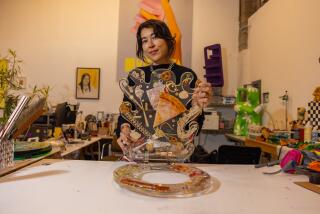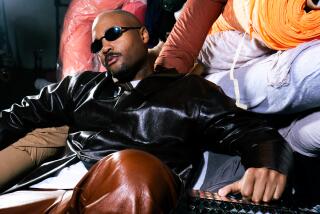THE GOODS : An Out-of-Office Experience : What will the workplace of the 21st Century be like? Design students envision smaller and down right portable businesses.
- Share via
The workplace is changing,” declared design student Dominic Sharlette, handing out flyers to his audience at Pasadena’s Art Center College of Design. “It’s no longer the desk in the office. It’s in the car and it’s in the street. People today are working in the ‘in-between’ places.”
Sharlette’s response to these changes is the Totem, a trim carrying case loaded with cellular phone and photo fax, audio recorder, answering machine and rechargeable battery pack. He designed it after studying the work routine of free-lance photographers.
“They are constantly on the move,” he said, “making calls and getting called for work.”
Sharlette was one of 20 students unveiling products for the changing workplace as they wrapped up a term project at the Art Center last week.
The students had been challenged to invent better tools for the smaller, less centralized businesses that are evolving in the information age.
The project was sponsored by Prince, which designs interior trim systems for cars; Herman Miller, office furniture designer, and Stanley, manufacturer of home products. The three corporations envision an overlapping of their designs.
“The students were asked to define the problem of workplace changes,” said Ray Smith, one of three faculty instructors on the project, “then create the solution--the tools or products that might be envisioned for the future office.”
And what does the future hold? Sweeping aside the traditional prediction of isolated workers chained to their electronic cottages, the student designers depicted a generation of freewheeling road warriors, liberated from a 9-to-5 desk routine by flexible transportation and a dazzling new generation of electronic office tools. For instance:
* “Nobody wants to be immobile and surrounded by a bunch of screens,” said Joao Amorim, whose family auto combined a “traditional furniture feeling” with enough computers to keep parents tuned to the office while transporting their children to school.
* “People want freedom to work how they please, when they please and where they please,” said Troy Arnold III. His solution is a conventional-looking briefcase that opens up to offer all the components of a home office--starting with the leather case itself, which is actually a flexible computer screen.
* “In the information era we can work wherever we happen to be,” said Ming-Jen Huang, who designed a set of teleconferencing toolsas basic furnishings for a hotel room “so anyone can attend a conference while traveling.”
*
With existing technology as a starting point, the students were encouraged to stretch their imaginations in applying it. The resulting designs--illustrated by sketches, photographs, cartoons, renderings, paintings, videos and full-scale models--offered many solutions for capturing the 21st-Century information flow.
One major theme was information processing on wheels. “This vehicle is an office,” said Jae Hur, who studied the daily routine of a UPS delivery driver. His redesigned truck moves the packages to the driver in sequence by computerized conveyor belt, and has a map screen and refrigerator and beverage dispenser (“I noticed they carried food with them and had to stop for soft drinks,” he said.)
Ken Yi, who spent time with a television news van, found a way to use the “time wasted while going to a story and coming back” by equipping the vehicle with a workstation for editing and relaying video images to the TV station. And he added a rooftop camera that could be activated the minute the van approached a news scene, such as a fire. Just the thing for drive-by news coverage.
Tylor Garland endorses the idea of “your car as a little working capsule,” but noted that people with car phones and note pads on the dashboard seem very distracted. His “Adam’s Apple” has two parts: an optical recognition scanner that can read aloud any document you want to hear while driving, and a tapeless recorder that picks up any thoughts you dictate.
“It lets you work without taking your eyes off the road or hands off the wheel,” he says. “You can absorb information at will.”
*
Others were also concerned with auto safety. Taking security to the limits, Hans Moritz designed a “pod with bumpers,” intended to absorb extreme stress. The advanced impact system coupe incorporates multiple air bags as interior design, is protected by oversize front and rear bumpers, and sports a rear fin that can flood a 50-foot radius with light.
James Lim’s research yielded this insight, which most parents learn the hard way: “A young couple has a hard time managing kids in the car.” So, his family vehicle lowers the bucketed back seats into an entertainment area with large sightseeing windows and equipped with a computer-game screen.
Not everyone foresees a future on wheels. “I don’t want to stay in my car any more than I have to,” said Peter O’Rourke. His pay-per-use satellite module--to be located in airports, convention centers or other busy places--alleviates the need for people to drag around laptops and cellular phones. An entry card, programmed with such personal data as software preferences, on-line memberships and even seating adjustments, converts the module to a virtual branch office.
Wilhelm Oehl sees no need to hit the road in the 21st Century.
“Based on all the information we’ll have from Internet and on-line services, there will be plenty to work with,” he said.
His home-office information module integrates computer pads, speakers, CD-ROM and triple-screen into a handsome piece of laminated furniture.
“It’s designed also for a wheelchair,” he explained, “so people with disabilities can compete in the business world of tomorrow.”
More to Read
Inside the business of entertainment
The Wide Shot brings you news, analysis and insights on everything from streaming wars to production — and what it all means for the future.
You may occasionally receive promotional content from the Los Angeles Times.










